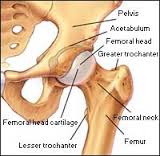Symptoms
As the name suggests, Snapping hip syndrome is a pathology of the hip joint characterised by an audible ‘snap’ or ‘pop’ with movement. This can be caused by a number of musculoskeletal dysfunctions and may or may not be painful.
Anatomy of the hip joint
The hip joint is a ball and socket joint, formed from the top of the femur (thigh bone) and the cup shaped ‘socket’ of the acetabulum (pelvis). The acetabulum has a ring of cartilage surrounding it which helps to stabilise the joint and avoid dislocation. The joint is surrounded by muscles, ligaments and tendons which allow a large range of movement whilst keeping the joint strong and stable. Sacs called Bursa sit between muscles and bones to allow smooth movements and cushioning.
Causes
There are five common causes of snapping hip syndrome, which your physiotherapist will need to determine to be able to treat you effectively.
1) The ilio-tibial band (ITB) passing over the hip bone. The ITB is a band of connective tissue which passes over the part of the hip bone at the side of your leg – the greater trochanter. As you bend and straighten your leg, the ITB passes from behind to in- front of the greater trochanter, and this can cause a snapping sound.
2) The Iliopsoas tendon (hip flexor tendon) attaches to the inner thigh and can also cause a snapping sound with hip movement.
3) The Rectus Femoris tendon (part of the Quadriceps muscle) attaches into the pelvis, through the ball and socket joint of your hip. As you bend and straighten your hip, the tendon can snap over the ball part of the joint causing a snapping sound.
4) Damage to the cartilage in your hip joint, or small fragments of ‘floating’ bone can also cause a snapping sound. These are the least common causes of snapping hip syndrome.
5) Snapping of the hamstring tendon over the Ischial Tuberosity (bum bone) can cause snapping hip syndrome at back of the hip.
Treatment
If you think you may have Snapping hip syndrome you will need to see a Physiotherapist who will assess you to establish what is causing the snapping sound and/ or pain. Treatment may include massage, mobilisations, stretches and strengthening work. Whilst you are waiting for an appointment modify your exercise routine so as not to make the injury any worse, ice the area and see your local pharmacist for pain relief medication.

